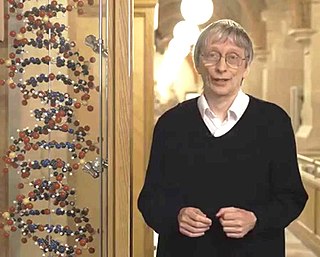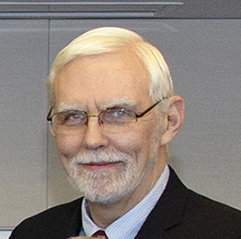 W
WQuantum computing is a type of computation that harnesses the collective properties of quantum states, such as superposition, interference, and entanglement, to perform calculations. The devices that perform quantum computations are known as quantum computers. Though current quantum computers are too small to outperform usual (classical) computers for practical applications, they are believed to be capable of solving certain computational problems, such as integer factorization, substantially faster than classical computers. The study of quantum computing is a subfield of quantum information science.
 W
WPaul A. Benioff is an American physicist who helped pioneer the field of quantum computing. Benioff is best known for his research in quantum information theory during the 1970s and 80s that demonstrated the theoretical possibility of quantum computers by describing the first quantum mechanical model of a computer. In this work, Benioff showed that a computer could operate under the laws of quantum mechanics by describing a Schrödinger equation description of Turing machines. Benioff's body of work in quantum information theory has continued on to the present day and has encompassed quantum computers, quantum robots, and the relationship between foundations in logic, math, and physics.
 W
WD-Wave Systems Inc. is a Canadian quantum computing company, based in Burnaby, British Columbia, Canada. D-Wave was the world's first company to sell computers to exploit quantum effects in their operation. D-Wave's early customers include Lockheed Martin, University of Southern California, Google/NASA and Los Alamos National Lab.
 W
WDavid Elieser Deutsch is a British physicist at the University of Oxford. He is a Visiting Professor in the Department of Atomic and Laser Physics at the Centre for Quantum Computation (CQC) in the Clarendon Laboratory of the University of Oxford. He pioneered the field of quantum computation by formulating a description for a quantum Turing machine, as well as specifying an algorithm designed to run on a quantum computer. He has also proposed the use of entangled states and Bell's theorem for quantum key distribution and is a proponent of the many-worlds interpretation of quantum mechanics.
 W
WAn electron-on-helium qubit is a quantum bit for which the orthonormal basis states |0⟩ and |1⟩ are defined by quantized motional states or alternatively the spin states of an electron trapped above the surface of liquid helium. The electron-on-helium qubit was proposed as the basic element for building quantum computers with electrons on helium by Platzman and Dykman in 1999.
 W
WRichard Phillips Feynman was an American theoretical physicist, known for his work in the path integral formulation of quantum mechanics, the theory of quantum electrodynamics, the physics of the superfluidity of supercooled liquid helium, as well as his work in particle physics for which he proposed the parton model. For contributions to the development of quantum electrodynamics, Feynman received the Nobel Prize in Physics in 1965 jointly with Julian Schwinger and Shin'ichirō Tomonaga.
 W
WElanor H. Huntington is a Professor of Quantum Cybernetics at the Australian National University. She is the Dean of Engineering and Computer Science. She leads a research program in the Australian Research Council Centre of Excellence for Quantum Computation and Communication Technology.
 W
WIBM Q System One is the first circuit-based commercial quantum computer, introduced by IBM in January 2019. IBM Q System One is a 20-qubit computer.
 W
WThe Intelligence Advanced Research Projects Activity (IARPA) is an organization within the Office of the Director of National Intelligence responsible for leading research to overcome difficult challenges relevant to the United States Intelligence Community. IARPA characterizes its mission as follows: "To envision and lead high-risk, high-payoff research that delivers innovative technology for future overwhelming intelligence advantage."
 W
WIonQ is a quantum computing hardware and software company based in College Park, Maryland. They are developing a general-purpose trapped ion quantum computer and software to generate, optimize, and execute quantum circuits.
 W
WG. Peter Lepage is a Canadian American theoretical physicist and an academic administrator. He was the Harold Tanner Dean of the College of Arts and Sciences at Cornell University from 2003 to 2013.
 W
WThe Mølmer–Sørensen gate is a two qubit gate used in quantum computing. It was proposed by Klaus Mølmer and Anders Sørensen. Their proposal also extends to gates on more than two qubits.
 W
WAndrea Morello, is the Scientia Professor of quantum engineering in the School of Electrical Engineering and Telecommunications at the University of New South Wales, and a Program Manager in the ARC Centre of Excellence for Quantum Computation and Communication Technology (CQC2T). Morello is the head of the Fundamental Quantum Technologies Laboratory at UNSW.
 W
WThe National Quantum Initiative Act is an Act of Congress passed on December 13, 2018 and signed into law on December 21, 2018. The law gives the United States a plan for advancing quantum technology, particularly quantum computing. It was passed unanimously by the United States Senate and was signed into law by President Donald Trump. The National Quantum Initiative (NQI) provides an umbrella under which a number of government agencies develop and operate programs related to improving the climate for quantum science and technology in the US, coordinated by The National Quantum Coordination Office. These agencies include the National Institute of Standards and Technology (NIST), the National Science Foundation (NSF), and the Department of Energy (DOE). Under the authority of the NQI, the NSF and the DOE have established new research Centers and Institutes, and NIST has established The Quantum Economic Development Consortium (QED-C), a consortium of industrial, academic, and governmental entities.
 W
WThe nitrogen-vacancy center is one of numerous point defects in diamond. Its most explored and useful property is its photoluminescence, which allows observers to read out its spin-state. The NV center's electron spin, localized at atomic scales, can be manipulated at room temperature by external factors such as magnetic, or electric fields, microwave radiation, or light, resulting in sharp resonances in the intensity of the photoluminescence. These resonances can be explained in terms of electron spin related phenomena such as quantum entanglement, spin–orbit interaction and Rabi oscillations, and analysed using advanced quantum optics theory. An individual NV center can be used as a basic unit for a quantum computer, a qubit, used f.e. for quantum cryptography. Further potential applications in novel fields of electronics and sensing include spintronics, masers, and quantum sensors. If the charge is not specified the term "NV center" refers to the negatively charged NV− center.
 W
WQuantum Computation and Quantum Information is a textbook about quantum information science written by Michael Nielsen and Isaac Chuang, regarded as a standard text on the subject. It is informally known as "Mike and Ike", after the candies of that name. The book assumes minimal prior experience with quantum mechanics and with computer science, aiming instead to be a self-contained introduction to the relevant features of both. The focus of the text is on theory, rather than the experimental implementations of quantum computers, which are discussed more briefly.
 W
WQuantum Computing Since Democritus is a 2013 book on quantum information science written by Scott Aaronson. It is loosely based on a course Aaronson taught at the University of Waterloo, Canada, the lecture notes for which are available online.
 W
WQuantum simulators permit the study of quantum system in a programmable fashion. In this instance, simulators are special purpose devices designed to provide insight about specific physics problems. Quantum simulators may be contrasted with generally programmable "digital" quantum computers, which would be capable of solving a wider class of quantum problems.
 W
WSycamore is a quantum processor created by Google Inc.'s Artificial Intelligence division. It has 53 qubits.
 W
WThe UK National Quantum Technologies Programme (UKNQTP) is a programme set up by the UK government to translate academic work on quantum mechanics, and the effects of quantum superposition and quantum entanglement into new products and services. It brings UK physicists and engineers together with companies and entrepreneurs who have an interest in commercialising the technology.
 W
WXanadu Quantum Technologies is a Canadian quantum computing hardware and software company headquartered in Toronto, Ontario. The company develops cloud accessible photonic quantum computers and develops open-source software for quantum machine learning and simulating quantum photonic devices.